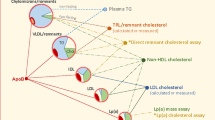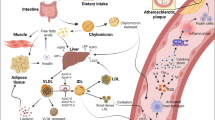Abstract
A recently developed assay for quantification of remnant-like particle cholesterol has provided considerable evidence that reinforces the concept that elevated levels of plasma remnants are associated with increased cardiovascular disease in different populations and distinct patient groups. In this review, we provide a brief summary of the most recently published studies, emphasizing the clinical relevance of remnant analysis. We discuss recent evidence that sheds light on the mechanisms that may underlie the atherogenicity of remnant lipoproteins. Taken together, these data provide new insight into the significance of remnant lipoproteins in the onset and development of premature atherosclerosis.
Similar content being viewed by others
References and Recommended Reading
Yusuf S, Reddy S, Ounpuu S, et al.: Global burden of cardiovascular diseases: part I: general considerations, the epidemiologic transition, risk factors, and impact of urbanization. Circulation 2001, 104:2746–2753.
Sirtori CR, Calabresi L, Marchioli R, et al.: Cardiovascular risk changes after lipid lowering medications: are they predictable? Atherosclerosis 2000, 152:1–8.
Brinton EA, Nanjee MN, Hopkins PN: Triglyceride-rich lipoprotein remnant levels and metabolism: time to adopt these orphan risk factors? J Am Coll Cardiol 2004, 43:2233–2235.
Guerin M, Egger P, Soudant C, et al.: Cholesteryl ester flux from HDL to VLDL-1 is preferentially enhanced in type IIB hyperlipidemia in the postprandial state. J Lipid Res 2002, 43:1652–1660.
Cohn JS, Marcoux C, Davignon J: Detection, quantification, and characterization of potentially atherogenic triglyceride-rich remnant lipoproteins. Arterioscler Thromb Vasc Biol 1999, 19:2474–2486.
Nakajima K, Saito T, Tamura A, et al.: Cholesterol in remnant-like lipoproteins in human serum using monoclonal anti apoB-100 and anti apo A-I immunoaffinity mixed gels. Clin Chim Acta 1993, 223:53–71.
Leary ET, Wang T, Baker DJ, et al.: Evaluation of an immunoseparation method for quantitative measurement of remnant-like particle-cholesterol in serum and plasma. Clin Chem 1998, 44:2490–2498.
Marcoux C, Tremblay M, Fredenrich A, et al.: Plasma remnant-like particle lipid and apolipoprotein levels in normolipidemic and hyperlipidemic subjects. Atherosclerosis 1998, 139:161–171.
McNamara JR, Shah PK, Nakajima K, et al.: Remnant lipoprotein cholesterol and triglyceride reference ranges from the Framingham Heart Study. Clin Chem 1998, 44:1224–1232.
Twickler TB, Dallinga-Thie GM, Cohn JS, et al.: Elevated remnant-like particle cholesterol concentration: a characteristic feature of the atherogenic lipoprotein phenotype. Circulation 2004, 109:1918–1925.
Wang T, Nakjima K, Leary ET, et al.: Ratio of remnant-like particle-cholesterol to serum total triglycerides is an effective alternative to ultracentrifugal and electrophoretic methods in the diagnosis of familial type III hyperlipoproteinemia. Clin Chem 1999, 45:1981–1987.
Gordon T, Kannel WB, Castelli WP, et al.: Lipoproteins, cardiovascular disease and death. The Framingham study. Arch Intern Med 1981, 141:1128–1131.
Austin MA, McKnight B, Edwards KL, et al.: Cardiovascular disease mortality in familial forms of hypertriglyceridemia: a 20-year prospective study. Circulation 2000, 101:2777–2782.
Devaraj S, Vega G, Lange R, et al.: Remnant-like particle cholesterol levels in patients with dysbetalipoproteinemia or coronary artery disease. Am J Med 1998, 104:445–450.
Tanaka A, Ejiri N, Fujinuma Y, et al.: Remnant-like particles and restenosis of coronary arteries after PTCA. Ann N Y Acad Sci 1995, 748:595–598.
Sakata K, Miho N, Shirotani M, et al.: Remnant-like particle cholesterol is a major risk factor for myocardial infarction in vasospastic angina with nearly normal coronary artery. Atherosclerosis 1998, 136:225–231.
Yamaguchi H, Homma Y, Handa S: Biochemical markers of vasospastic coronary artery disease. Nutr Metab Cardiovasc Dis 2003, 13:365–371.
Miwa K, Makita T, Ishii K, et al.: High remnant lipoprotein levels in patients with variant angina. Clin Cardiol 2004, 27:338–342.
Masuoka H, Ishikura K, Kamei S, et al.: Predictive value of remnant-like particles cholesterol/high-density lipoprotein cholesterol ratio as a new indicator of coronary artery disease. Am Heart J 1998, 136:226–230.
Inoue T, Saniabadi AR, Matsunaga R, et al.: Impaired endothelium-dependent acetylcholine-induced coronary artery relaxation in patients with high serum remnant lipoprotein particles. Atherosclerosis 1998, 139:363–367.
Takeichi S, Yukawa N, Nakajima Y, et al.: Association of plasma triglyceride-rich lipoprotein remnants with coronary atherosclerosis in cases of sudden cardiac death. Atherosclerosis 1999, 142:309–315.
Wang T, Elam MB, Forbes WP, et al.: Reduction of remnant lipoprotein cholesterol concentrations by cilostazol in patients with intermittent claudication. Atherosclerosis 2003, 171:337–342.
Karpe F, Boquist S, Tang R, et al.: Remnant lipoproteins are related to intima-media thickness of the carotid artery independently of LDL cholesterol and plasma triglycerides. J Lipid Res 2001, 42:17–21.
Masuoka H, Kamei S, Wagayama H, et al.: Association of remnant-like particle cholesterol with coronary artery disease in patients with normal total cholesterol levels. Am Heart J 2000, 139:305–310.
Masuoka H, Kamei S, Ozaki M, et al.: Predictive value of remnant-like particle cholesterol as an indicator of coronary artery stenosis in patients with normal serum triglyceride levels. Intern Med 2000, 39:540–546.
McNamara JR, Shah PK, Nakajima K, et al.: Remnant-like particle (RLP) cholesterol is an independent cardiovascular disease risk factor in women: results from the Framingham Heart Study. Atherosclerosis 2001, 154:229–236.
Song J, Park H, Hong SH, et al.: Remnant-like particle cholesterol levels in Korean patients with coronary artery disease and non-insulin dependent diabetes mellitus. Clin Chem Lab Med 2000, 38:427–432.
Inoue T, Uchida T, Kamishirado H, et al.: Remnant-like lipoprotein particles as risk factors for coronary artery disease in elderly patients. Horm Metab Res 2004, 36:298–302.
Kugiyama K, Doi H, Takazoe K, et al.: Remnant lipoprotein levels in fasting serum predict coronary events in patients with coronary artery disease. Circulation 1999, 99:2858–2860.
Fukushima H, Kugiyama K, Sugiyama S, et al.: Comparison of remnant-like lipoprotein particles in postmenopausal women with and without coronary artery disease and in men with coronary artery disease. Am J Cardiol 2001, 88:1370–1373.
Fukushima H, Sugiyama S, Honda O, et al.: Prognostic value of remnant-like lipoprotein particle levels in patients with coronary artery disease and type II diabetes mellitus. J Am Coll Cardiol 2004, 43:2219–2224.
Bjorkegren J, Packard CJ, Hamsten A, et al.: Accumulation of large very low density lipoprotein in plasma during intravenous infusion of a chylomicron-like triglyceride emulsion reflects competition for a common lipolytic pathway. J Lipid Res 1996, 37:76–86.
Cohn JS: Postprandial lipid metabolism. Curr Opin Lipidol 1994, 5:185–190.
Cohn JS, McNamara JR, Cohn SD, et al.: Plasma apolipoprotein changes in the triglyceride-rich lipoprotein fraction of human subjects fed a fat-rich meal. J Lipid Res 1988, 29:925–936.
Karpe F, Steiner G, Olivecrona T, et al.: Metabolism of triglyceride-rich lipoproteins during alimentary lipemia. J Clin Invest 1993, 91:748–758.
Marcoux C, Hopkins PN, Wang T, et al.: Remnant-like particle cholesterol and triglyceride levels of hypertriglyceridemic patients in the fed and fasted state. J Lipid Res 2000, 41:1428–1436.
Ooi TC, Cousins M, Ooi DS, et al.: Postprandial remnant-like lipoproteins in hypertriglyceridemia. J Clin Endocrinol Metab 2001, 86:3134–3142.
Schaefer EJ, Audelin MC, McNamara JR, et al.: Comparison of fasting and postprandial plasma lipoproteins in subjects with and without coronary heart disease. Am J Cardiol 2001, 88:1129–1133.
Schreuder PC, Twickler TB, Wang T, et al.: Isolation of remnant particles by immunoseparation: a new approach for investigation of postprandial lipoprotein metabolism in normolipidemic subjects. Atherosclerosis 2001, 157:145–150.
Twickler TB, Dallinga-Thie GM, Zelissen PM, et al.: The atherogenic plasma remnant-like particle cholesterol concentration is increased in the fasting and postprandial state in active acromegalic patients. Clin Endocrinol (Oxf) 2001, 55:69–75.
Tan KC, Tso AW, Ma OC, et al.: Determinants of postprandial triglyceride and remnant-like lipoproteins in type 2 diabetes. Diabetes Metab Res Rev 2004, In press.
Igarashi M, Hirata A, Yamauchi T, et al.: Clinical utility and approach to estimate postprandial hypertriglycemia by a newly designed oral fat-loading test. J Atheroscler Thromb 2003, 10:314–320.
Funada J, Sekiya M, Otani T, et al.: The close relationship between postprandial remnant metabolism and insulin resistance. Atherosclerosis 2004, 172:151–154.
Kim HS, Abbasi F, Lamendola C, et al.: Effect of insulin resistance on postprandial elevations of remnant lipoprotein concentrations in postmenopausal women. Am J Clin Nutr 2001, 74:592–595.
Ai M, Tanaka A, Ogita K, et al.: Relationship between plasma insulin concentration and plasma remnant lipoprotein response to an oral fat load in patients with type 2 diabetes. J Am Coll Cardiol 2001, 38:1628–1632.
Joseph A, Ackerman D, Talley JD, et al.: Manifestations of coronary atherosclerosis in young trauma victims—an autopsy study. J Am Coll Cardiol 1993, 22:459–467.
Proctor SD, Mamo JC: Retention of fluorescent-labelled chylomicron remnants within the intima of the arterial wall—evidence that plaque cholesterol may be derived from post-prandial lipoproteins. Eur J Clin Invest 1998, 28:497–503.
Wilhelm MG, Cooper AD: Induction of atherosclerosis by human chylomicron remnants: a hypothesis. J Atheroscler Thromb 2003, 10:132–139.
Skalen K, Gustafsson M, Rydberg EK, et al.: Subendothelial retention of atherogenic lipoproteins in early atherosclerosis. Nature 2002, 417:750–754.
Tabas I: Nonoxidative modifications of lipoproteins in atherogenesis. Annu Rev Nutr 1999, 19:123–139.
Gianturco SH, Bradley WA: Pathophysiology of triglyceriderich lipoproteins in atherothrombosis: cellular aspects. Clin Cardiol 1999, 22:SII-7–SII-14.
Chung BH, Tallis G, Yalamoori V, et al.: Liposome-like particles isolated from human atherosclerotic plaques are structurally and compositionally similar to surface remnants of triglyceride-rich lipoproteins. Arterioscler Thromb 1994, 14:622–635.
Domoto K, Taniguchi T, Takaishi H, et al.: Chylomicron remnants induce monocyte chemoattractant protein-1 expression via p38 MAPK activation in vascular smooth muscle cells. Atherosclerosis 2003, 171:193–200.
Reape TJ, Groot PH: Chemokines and atherosclerosis. Atherosclerosis 1999, 147:213–225.
Takeya M, Yoshimura T, Leonard EJ, et al.: Detection of monocyte chemoattractant protein-1 in human atherosclerotic lesions by an anti-monocyte chemoattractant protein-1 monoclonal antibody. Hum Pathol 1993, 24:534–539.
Doi H, Kugiyama K, Sugiyama S, et al.: Remnant lipoproteins induce proatherothrombogenic molecules in endothelial cells through the redox-sensitive mechanism. Circulation 2000, 102:670–676.
Twickler TB, Dallinga-Thie GM, Visseren FL, et al.: Induction of postprandial inflammatory response in adult onset growth hormone deficiency is related to plasma remnant-like particle-cholesterol concentration. J Clin Endocrinol Metab 2003, 88:1228–1233.
Oi K, Shimokawa H, Hiroki J, et al.: Remnant lipoproteins from patients with sudden cardiac death enhance coronary vasospastic activity through upregulation of rho-kinase. Arterioscler Thromb Vasc Biol 2004, 24:918–922.
Hu E, Lee D: Rho kinase inhibitors as potential therapeutic agents for cardiovascular diseases. Curr Opin Invest Drugs 2003, 4:1065–1075.
Conti E, Carrozza C, Capoluongo E, et al.: Insulin-like growth factor-1 as a vascular protective factor. Circulation 2004, 110:2260–2265.
Beaudeux JL, Giral P, Bruckert E, et al.: Matrix metalloproteinases, inflammation and atherosclerosis: therapeutic perspectives. Clin Chem Lab Med 2004, 42:121–131.
Takahashi S, Sakai J, Fujino T, et al.: The very low density lipoprotein (VLDL) receptor—a peripheral lipoprotein receptor for remnant lipoproteins into fatty acid active tissues. Mol Cell Biochem 2003, 248:121–127.
Batt KV, Avella M, Moore EH, et al.: Differential effects of low-density lipoprotein and chylomicron remnants on lipid accumulation in human macrophages. Exp Biol Med 2004, 229:528–537.
Pentikainen MO, Oksjoki R, Oorni K, et al.: Lipoprotein lipase in the arterial wall: linking LDL to the arterial extracellular matrix and much more. Arterioscler Thromb Vasc Biol 2002, 22:211–217.
Author information
Authors and Affiliations
Rights and permissions
About this article
Cite this article
Twickler, T., Dallinga-Thie, G., Chapman, M. et al. Remnant lipoproteins and atherosclerosis. Curr Atheroscler Rep 7, 140–147 (2005). https://doi.org/10.1007/s11883-005-0037-x
Issue Date:
DOI: https://doi.org/10.1007/s11883-005-0037-x




